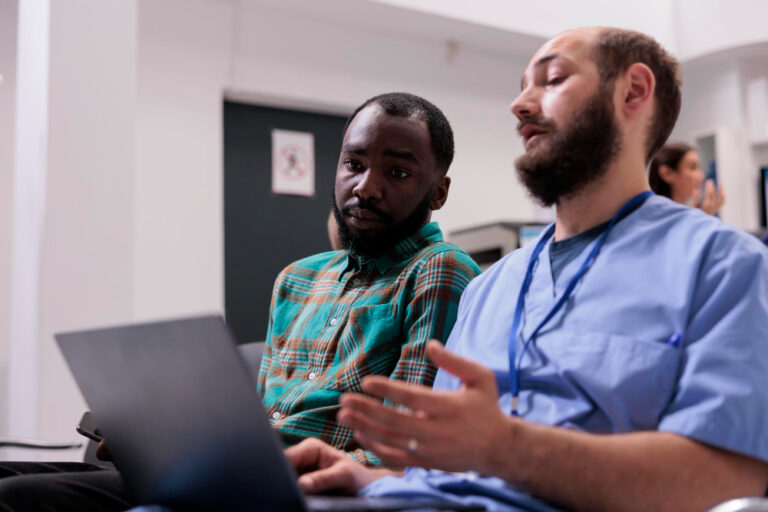The Evita Alonso iHuman case study presents a clinically relevant scenario that challenges nursing students to accurately assess and manage complex gastrointestinal symptoms. In this case, Mrs. Evita Alonso, a 48-year-old female, arrives at an urgent care clinic complaining of severe and persistent right upper quadrant (RUQ) abdominal pain, nausea, vomiting, and anorexia—symptoms indicative of a possible biliary disorder. The case demands careful clinical reasoning to differentiate between critical diagnoses such as ascending cholangitis, cholecystitis, and pancreatitis.
Evita Alonso iHuman Assignment Help
At dnpwritinghelp.com, we provide expert support for nursing students tackling the Evita Alonso iHuman assignment. Our team offers step-by-step documentation help, accurate diagnosis justification, and treatment planning based on current evidence-based guidelines. Whether you’re preparing a SOAP note, completing your documentation, or need clarification on differential diagnoses, we ensure that your assignment is completed with precision and professionalism.
Table of Contents
Evita Alonso History, Differencial Diagnostics
History of Present Illness
Mrs. Evita Alfonso is a 48-year-old female who presented to an urgent care clinic with a two-week history of intermittent, progressively worsening right upper quadrant (RUQ) abdominal pain. The pain has significantly intensified over the past two days and radiates to her right shoulder. She also reports nausea, vomiting, and anorexia, which began two days ago. The patient describes previous similar episodes over the past year that were self-limiting. Her family history is positive for biliary disease (mother), which is an important risk factor.
Upon examination, the patient exhibited a low-grade fever, mild scleral icterus, RUQ tenderness with guarding, and a positive Murphy’s sign, suggesting underlying biliary pathology.
Pain Characteristics
- Onset: Two weeks ago; worsened considerably in the past two days
- Location: RUQ, radiating to the right shoulder
- Duration: Persistent in this episode; previous episodes lasted 1–2 days
- Character: Crampy, gnawing, and achy
- Aggravating/Alleviating Factors: Worsens with meals; not relieved by NSAIDs or antacids
- Related Symptoms: Nausea, vomiting, anorexia; denies exposure to ill contacts
- Treatments Tried: Over-the-counter antacids and ibuprofen, which offered no relief
- Pain Scale: Initially 2–3/10, progressing to 6–7/10; affecting daily activities and work attendance
Primary Diagnosis: Ascending Cholangitis
The leading diagnosis is Ascending Cholangitis, an infection of the biliary tract caused by obstruction—commonly due to gallstones. Symptoms typically include jaundice, RUQ pain, and fever. Damien’s symptoms—especially RUQ tenderness, shoulder radiation, scleral icterus, and a positive Murphy’s sign—align with this diagnosis.
Cholangitis is a serious condition that often requires hospital admission, IV antibiotics, and sometimes surgical intervention such as a cholecystectomy. If necessary, an MRCP (Magnetic Resonance Cholangiopancreatography) may be performed to evaluate biliary duct obstruction. Surgery is usually performed laparoscopically and carries minimal risk. According to Crowley & Martin (2022), gallstone disease is more likely in overweight individuals, which should also be considered in patient education.
Differential Diagnoses
1. Cholecystitis
This condition involves inflammation of the gallbladder, usually due to obstruction by gallstones. Common symptoms include severe RUQ pain, tenderness, nausea, vomiting, and radiation to the right shoulder—symptoms that are consistent with Evita’s presentation.
2. Acute Pancreatitis
Pancreatitis presents with epigastric pain radiating to the back, nausea, vomiting, and fever. Although Evita’s pain is more RUQ-focused, the overlap in GI symptoms necessitates consideration of this differential.
3. Peptic Ulcer Disease (PUD)
PUD results from erosion of the stomach lining due to acid exposure. Symptoms often include burning abdominal pain, nausea, bloating, and vomiting. Though not the most likely diagnosis, Evita’s complaint of long-term stomach pain justifies consideration.
Management Plan
Pharmacologic Care
- Start IV fluids
- Collect 2 blood cultures
- Administer Ertapenem 1g IV
- Consult general surgery for evaluation and surgical planning
Supportive Care
- Make patient NPO (nothing by mouth)
- Initiate IV normal saline (0.9%): 100ml bolus, then 50ml/hr
- Administer Zosyn 3.375g IV q6h for 7 days
- Give Zofran 4mg IV q6h PRN for nausea
- Monitor blood glucose every 4 hours due to NPO status
Patient Education
The patient was informed of the diagnosis and the need for further evaluation due to the presence of fever and suspected biliary infection. The plan for surgical consultation and possible gallbladder removal was explained, along with the risks and expectations of the procedure. The patient expressed understanding.
Follow-Up
- Monitor and alert staff for increased pain, fever, vomiting, or any new symptoms during her ED stay
- Follow up in the outpatient clinic 1–2 weeks post-operatively
- If gallbladder removal is performed, advise on a low-fat diet, smaller meals, and avoiding heavy lifting
- Contact a physician if there are signs of infection, bleeding, or uncontrolled pain
References
- Chatterjee, S., Mavani, A., & Bhattacharyya, J. (2022). Chemistry and mechanism of the diseases caused by digestive disorders. In Nutrition and Functional Foods in Boosting Digestion, Metabolism, and Immune Health (pp. 3–14). Academic Press.
- Crowley, K., & Martin, K. A. (2022). Patient education: Gallstones (The Basics). UpToDate.
- Hatnoorkar, S. A., & Rajpal, C. (2022). Homoeopathy and Acid Peptic Disorder. Journal of Medical and Pharmaceutical Innovation, 9(45).
If you’re a student seeking structured clinical documentation and expert guidance on Evita Alonso iHuman assignment help, DNPWritingHelp.com is here to support you with reliable, plagiarism-free responses tailored to your course requirements. Let us help you succeed in Shadow Health and iHuman case studies with clarity and confidence.
Must Read:


